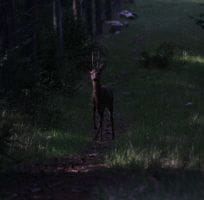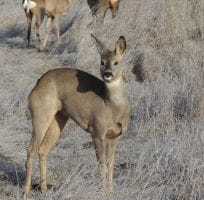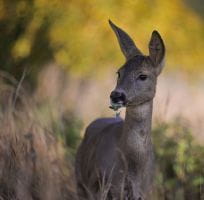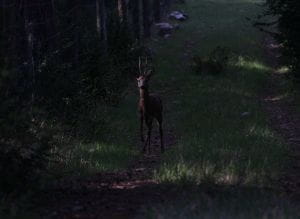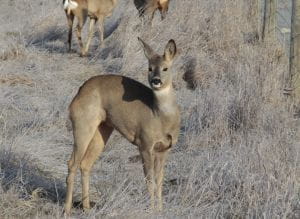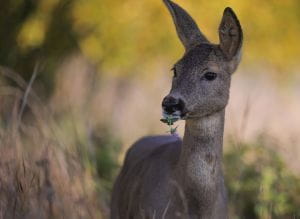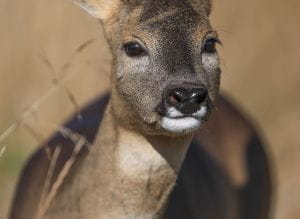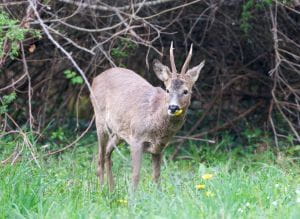A little history
The term “roe deer” designates several species on the planet. The closest cousin of the European roe deer (Capreolus capreolus), the Asian roe deer (Capreolus pygargus) is a species, in physique and behavior, very close to the European roe deer. The Asian roe deer lives on the eastern part of Eurasia (east coast of China, Korea, Mongolia, eastern part of Siberia) when the European roe deer lives on the western part.
3 other species of “roe deer” are found on Earth. They are, in fact, animals more closely related to deer or antelope: Andean roe deer in South America (cousins of reindeer and elk), white-tailed deer in North America (closer to deer than to roe deer) and the antelope-deer in southern Africa (closer to Kobs, African antelopes)
The European roe deer is Europe’s smallest cervid, found throughout the continent with the exception of the islands of Corsica, Sicily, Iceland and Ireland.
In France, the roe deer is present almost everywhere, with the exception of Corsica. This geographical distribution has not always been so extensive.
At the end of the Middle Ages, the roe deer became a common sight.
By the end of the 17th century, roe deer had all but disappeared in France, as in Europe for that matter. The reasons were well known: urbanization and the destruction of wild ecosystems.
It wasn’t until the end of the Second World War, that the area of presence of this forest animal increased following the implementation of major national hunting management plans and restocking operations recommended by the Hunting Federation (same dynamics as for the red deer).
For the last fifty years or so, there have been fluctuations in the dynamics of roe deer populations, but no major upheavals, as this ubiquitous species is capable of occupying all environments. A forest animal, it can also go out into cultivated land (cereal fields, etc.) or meadows, on the edges, to feed.
When conditions are favourable, it can be found in a wide variety of habitats.
When conditions are favorable, it can even form a herd of more than 50 individuals.
Finally, an important piece of information: the Jurassien massif is an area where roe deer have always thrived in France.
A year in the life of the roe deer
From rut to birth…
In autumn, the bucks form small groups. They moult in October, their coats changing from russet to gray-brown. During winter, mixed groups of varying size form, often visible in stubble fields or ploughed fields.
Male deer shed their antlers in November. Regrowth begins in December and lasts until early spring. These antlers reach their maximum size between March and April. They are velvet-covered, as in red deer (see antlers of red deer).
The antlers of male deer are velvet-covered, as in red deer (see antlers of red deer).
From February onwards, males start marking their territory. These markings intensify as the rut approaches, and the stags become solitary again until summer.
The rut takes place in midsummer, from mid-July to mid-August. The brocade, whose territory encompasses that of several young goats, actively roams its fiefdom and marks shrubs or young trees by rubbing against them.
Before mating, the males pursue the females at length on a more or less circular course known as a “witches’ circle”, these circular ballets most often ending with a protrusion!
The roe deer breeds in summer, but gestation takes place in two stages.
After fertilization, the egg stops developing for around 5 months. This halt in embryonic development is called a diapause.
At the end of December/beginning of January, the embryo implants in the uterus, more than 4 months after fertilization! This peculiarity is called delayed ovo-implantation. It exists in a few other species, including the otter and the mink.
The actual gestation period, which begins once the embryo has resumed development, lasts just over 5 months (around 140 days).
The scientific hypothesis is that this “embryonic pause” allows the fawn to be born during the summer months, when outside temperatures warm up and spring vegetation turns green. The fawn can then camouflage itself in the tall grass, and the mother can feed in the best conditions to produce quality milk. The fawn’s reddish-brown coat spotted with white ensures camouflage before it learns to run.
Goat kids give birth in late April, early May; usually two young weighing 1 to 2 kg each. The fawns, which would be able to move very quickly, remain hidden in the vegetation. The mother spends little time with them, joining them only for suckling. She then grooms them carefully, even eating their droppings. All these measures are aimed at escaping predators!
About their third week, the fawns will follow the goat, leaving her only 10 to 11 months later. The actual suckling period lasts 2 to 3 months.
A deer-like diet resulting in territorial competition…
Like its cousin the red deer, the roe deer feeds mainly on woody or herbaceous plants, grasses, leaves, berries, acorns, mushrooms, cereals and vegetables. In winter, roe deer strip the bark from young trees to lick the sweet cambium from the trunks. This similarity in diet to that of the deer leads to considerable competition between the two species. Far less imposing than the deer, the shy roe deer tends to flee ecosystems where the deer is too abundant.
The roe deer is a prey of great importance to the local population.
The roe deer is a prey of choice for wolves, lynx and…man.
Originally diurnal, like the red deer for that matter, the roe deer became crepuscular or nocturnal because it was too often disturbed by human activities. Its social life is organized around the young bucks, which gather in herds with the young of the year. In France, brocards tend to live alone. However, in some Central European countries with large populations, it’s not uncommon to see herds made up of young males.
In winter, males and females live together in the same herd.
In winter, males and females can form mixed herds, which undoubtedly make it easier to cope with hostile conditions.
